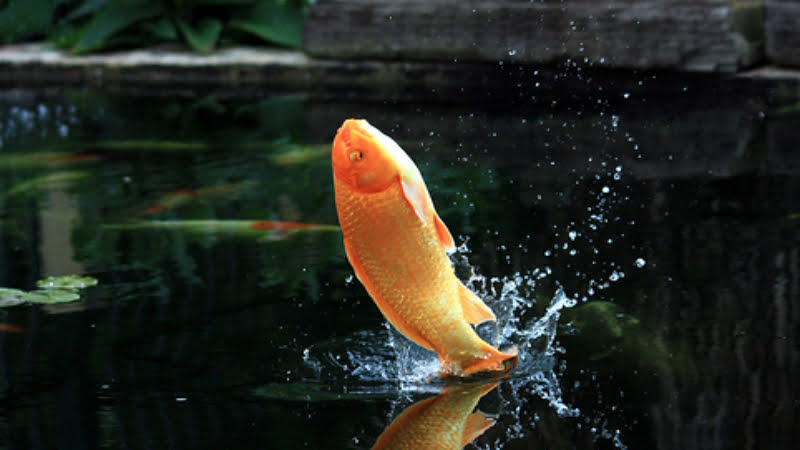For the sake of their own survival, koi fish must clearly remain submerged. Even more puzzlingly, they typically end up drowning unless we can get them back into the water as fast as possible. There is usually something wrong with the water that causes Koi fish to leap out of a perfectly good pond, even if it seems that way.
In this article, we give you several reasons why do koi fish jump and provide appropriate solutions. It can be hard to tell what the issue is by simply looking at the pond. For this reason, you’ll probably need to run tests and try a few solutions before the situation is resolved.
Why Do Koi Fish Jump?
Poor water quality
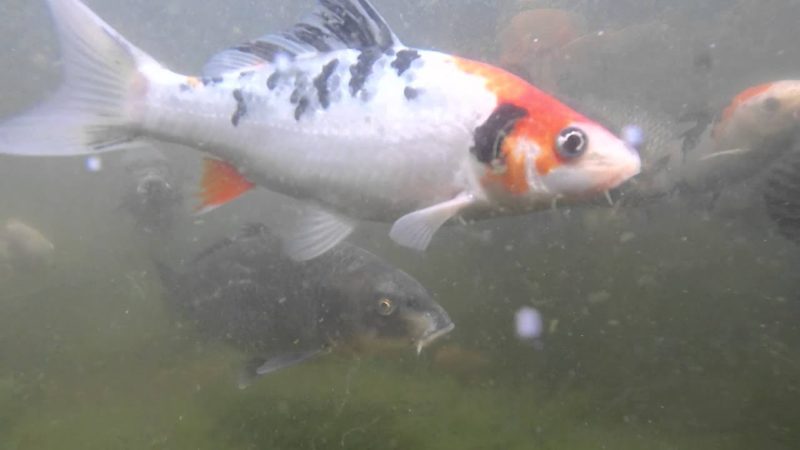
The fish may try to leap out of the water if the quality is bad. A common reason for them to try and avoid the water is because it is so uncomfortable. In the natural, if a fish can leap into another body of water, this may help them. When the water quality declines because of the presence of stagnant water, fish may be able to leap back into the river.
Nevertheless, things do not operate that way when koi fish live in a pond or tank. Trying to escape is a natural tendency for fish when their water environment is toxic or unbalanced. This is perhaps the most prevalent cause for Koi to leap from their water.
Lack of oxygen
Oxygen is essential for koi fish to thrive. If your water isn’t adequately oxygenated, your fish may not be able to breathe correctly. They may try to locate a source of oxygen by leaping out of the water.
Fish tend to swarm near the surface of the water when there is not enough oxygen in the water. In order to get the oxygen they require, you may notice them gasping for breath at the top. As a result of the fish being crammed together, it may seem as though they are intentionally jumping out of the pond.
The reason doesn’t always be because oxygen levels in the pond remain low for the whole time. This might be due to a lack of circulation in the pond, which can result in lower oxygen levels in specific locations. The absence of oxygen may cause the concentration of fish near the top of a body of water. The fish won’t be able to just move to a new region of the pond.
Aggression
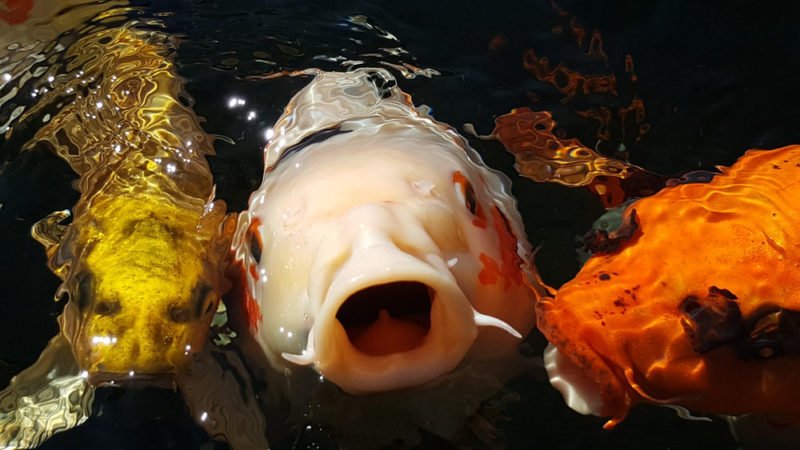
Fish may escape to safety if they feel threatened. A lot of them prefer leaping out of the water rather than being devoured, so that’s probably what they’ll do. In general, koi fish are not aggressive. When they’re mating, they may, on the other hand, be a little more frantic in their movements.
A fish may jump out of the water when it is being chased and might end up outside of the pond.
Exploring
There are times when Koi fish will jump out of the water in order to get a better view of something. They are certain species of fish that are more susceptible to this condition than others. Having successfully leaped out of the water and received a reward, the fish may choose to repeat the behavior or do it more often in the future.
It’s not always successful for the fish, though. Because their leaps aren’t always precise, it’s not unheard of for them to miss the water.
Conditioning
It’s not unusual for fish that leap outside the water to be “rewarded” with food. Because, after all, many Koi fish owners are awestruck when their fish emerge from the water. As a result, it is possible to misinterpret this as affection. Fish may come to identify humans and leap with food if you handfeed them often.
As a result, fish may tend to jump if they detect a human close in an effort to grab food. It’s possible that you’ve taught your fish to do this. Fortunately, they’re more likely to do this when no one is present, so the chance of their being hurt is minimal. You may be able to just return them to the water if they land on dry ground.
Threats of predation
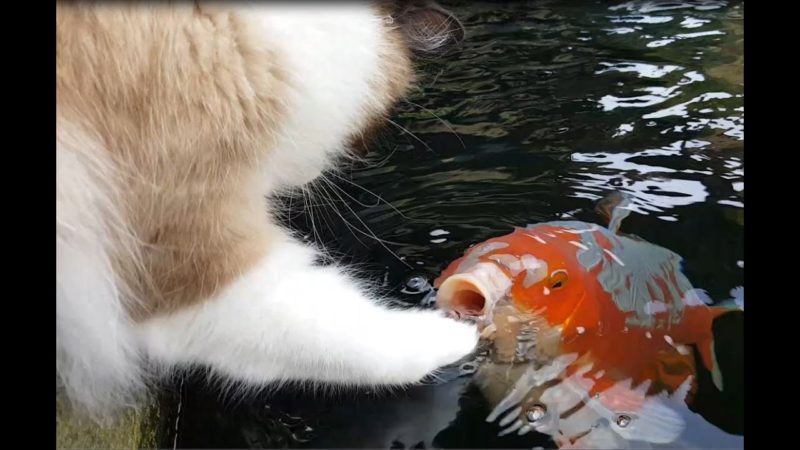
Some fish may try to flee from predators both within and outside the pond by jumping out of the water. It’s not uncommon to see coyotes trying to get a nibble out of a Koi fish tank, as well as other animals such as cats, birds, and otters. Since most of these attacks occur at night, you may not notice anything amiss unless you have a security camera pointed at the area in question.
Predation is clearly capable of causing a wide range of issues. As a result, the fish may get stressed or perhaps die outright from it. In addition, when fish are wounded, they are more susceptible to bacterial diseases.
How To Stop Koi Fish From Jumping
Improve the quality of the water
You should treat your water on a regular basis since you can never be certain that it is chemical-free. Actually, because the Japanese fill their koi ponds with mountain spring water, they have never had this issue. Of course, this water is the purest and the cleanest you’ll ever find.
It is ideal if you have a continuous supply of fresh water trickling down to your pond since this will guarantee that your pond is always replenished with fresh water.
Reduce overcrowding
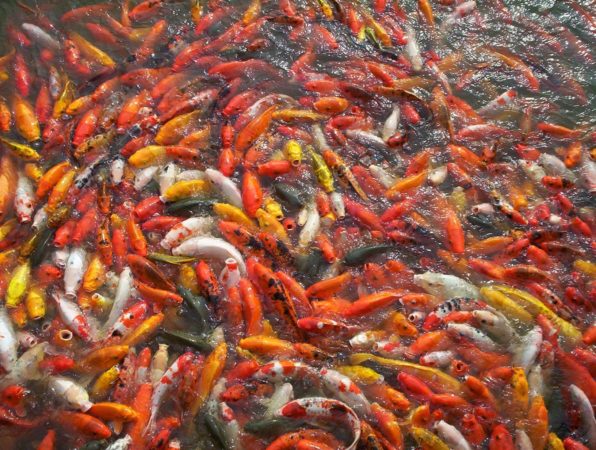
Overcrowding is a contributing factor to a wide range of issues. Having too many fish in an aquarium may lead to a buildup of waste that depletes oxygen levels. It is possible that the fish will become more aggressive, which will result in leaping actions on their part. In certain cases, stress may lead to sickness, which in turn can lead to even greater jumping.
You shouldn’t buy 30 koi fish. Instead, 10 is a reasonable number of them to maintain. Be aware that these fish reproduce. With additional fish, you’ll quickly run into overpopulation issues. It’s best to start with a much smaller number of fish than you think you’ll be able to care for. When there are fewer fish in the pond, there is less competition for food and hence a more pleasant atmosphere. Your fish will not flourish if you maintain the maximum number of fish in your pond.
Heighten the sides
The pond may need to be raised in order to keep your fish from escaping. By doing this, when the fish start making little leaps, they will no longer be able to get out of the pond because they will be unable to jump high enough. Additionally, it may keep fish from being eaten by predators. Your fish are secure if a cat’s arm can’t reach into the pond.
Based on your arrangement, this may or may not be a realistic solution.
Add netting
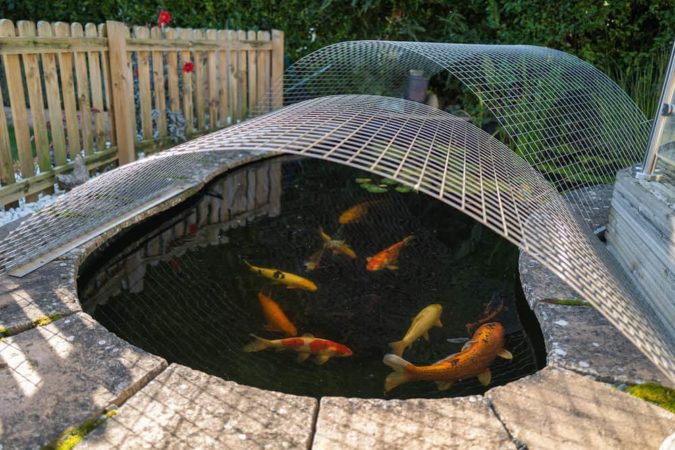
Installing netting to the top of your pond may not be the most visually appealing solution, but it is a simple method to protect your fish from escaping. The use of nets is recommended when dealing with an underlying issue and wanting to retain your fish in the pond until the situation can be resolved.
Predators won’t be able to get to your fish if you do this. The net may only need to be used at night in this case. Daytime is the best time to check at your pond since that is when the majority of predators aren’t out and about.
Increase oxygen
As a result of low oxygen levels, Koi fish often leave their ponds. If you want to enhance the oxygen level significantly, you may need to attempt a few different approaches.
Lower concentrations of dissolved oxygen are seen when the temperature of the water rises. As a result, ponds lose a lot of oxygen throughout the summer. Oxygen levels may be lowered by algae as well. Any pond’s oxygen level should be between 3 parts per million (ppm) and 10 parts per million (ppm). Using the proper test equipment, you should be able to determine whether low oxygen levels are to blame for your pond’s problems.
In order to raise the oxygen levels in your pond, make sure that there is enough water circulation. By increasing the volume of water flowing through the pond’s surface, more oxygen will be absorbed by the atmosphere. It will also discourage fish from swarming at the top of the pond since the bottom of the pond will have enough oxygen. Typically, a water fountain or cascade may be used to accomplish this.
Moreover, an air pump may also be used to enhance the quantity of oxygen in a room. By doing so, the water in the pond moves faster, allowing more oxygen to be released. Additionally, you may add oxygen stones that perform the same function as a pump but at a much greater scale. The water is agitated and circulated by the addition of air bubbles.
Jumping Height Of A Koi Fish
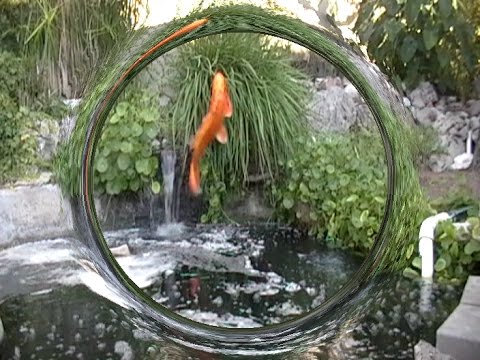
If you already know that koi fish can leap, you may be wondering how high they can go. For the most part, Koi will leap higher than you expect, maybe as high as six feet.
In fact, it’s fairly uncommon for them to rise at least a few feet above the ground. Make sure you’re prepared!
Therefore, the greatest therapy for stopping Koi from leaping out of the pond is prevention. Inspect and maintain their pond and water regularly, watch for new fish, and add netting as required. In order to save them from injuring or possibly killing themselves, this is the only thing you can do.
Time A Koi Fish Survived After Jumping Out Of Water
To put things in perspective, let’s imagine the worst-case situation first. Koi managed to leap out of the water and become trapped. If water isn’t available, how long can it last?
As a general rule, it’s not beneficial for fish to be out of the water. Any period spent without water might have long-term repercussions. Fortunately, if you rescue a stranded koi in time, it doesn’t have to be a death sentence.
There are several variables that affect how long a koi (or any fish for that matter) can live without water. The bigger the size of the fish, the longer it will be able to live. Clearly, outside temperature and humidity will also have a significant impact. If a fish is abandoned in a warm, dry place during midday in the summer, it will not survive well.
As members of the carp family, Koi are well-known for their tenacity. They’ve been known to live for many hours without water, but I wouldn’t recommend trying it yourself! As long as you keep an eye on your fish and don’t let them get out of the water in the first place, your Koi won’t have to die.
So, it’s also a good idea to keep a careful check on any new fish that may be entering the water. If it strands itself, you may be able to help them.
The Best Ways To Save A Jumping Koi Fish
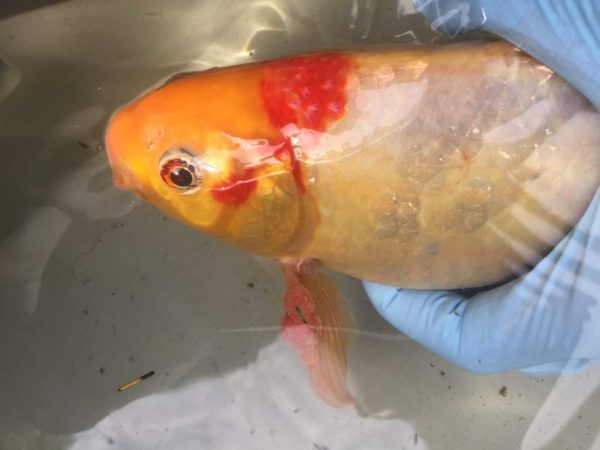
Again, a stranded koi is something we want to keep to a bare minimum. We’re also trying to save a stranded fish as quickly as possible.
In certain cases, it’s possible to save the life of a drowned koi if you locate it. Throwing them back into the water as fast as possible will be your first inclination. This is a natural reaction, but resist it. As soon as possible, get them back in the water. However, be as gentle as possible while doing so. You don’t want to inflict more stress on your fish’s nervous system.
For any fish that have been out of water for an extended period of time, you will have to hold them when you place them back in the water in order to stop them from turning upside down. Be sure to gently move them in the water. Keep doing this for as long as you have to. While it may take a while, you will surely be rewarded for your efforts in saving your beached fish.
Video: How To Stop Fish From Jumping
FAQs
Is it dangerous for Koi to jump outside the water for a long time?
In the absence of water, your koi fish are doomed to extinction. It’s possible that the fish may go outside of the water nearby, which might be deadly. The deadly stage is generally when the fish leaps out of the water and injures itself on the items outside the water, such as rocks, plants, and other such objects.
Whether it normal for koi fish to jump?
When Koi are first introduced to their new surroundings, they are more likely to exhibit this leaping behavior. Koi are very perceptive fish, and as such, they prefer to know their environment. Part of this entails investigating the outside borders of their pond. The waterfall and skimmer sections are the most common places to witness young koi jumping.
Koi fish can jump up to how high?
Captive koi fish are able to jump three feet in the air. However, when in their natural habitat, they may leap up to seven feet!
Is it true that Koi jump when they spawn?
It is true that koi fish leap when they spawn. Male fish engage in what is known as “koi spawning behavior” when they attempt to attract a female koi fish to spawn with them.
Are koi jumping for fun?
Usually, Koi do not leap as a kind of entertainment. When they’re threatened or just want to show off, they’ll leap. In addition, you may hear them hopping about as they pursue prey or as a kind of play.

Annette M. Chaney is an experienced marine biologist with over 20 years of experience as an aquarist and fishkeeper. She started her first aquarium at a young age, filling it with frogs and goldfish obtained from the ten-cent pet store.
Annette grew up caring for and breeding African Cichlids, which led to a hobby in high school that doubled as a profitable means. Attending Reed College gave her time to solidify herself as an accomplished aquarium caretaker with an eye for sales. After that, from 2009 – 2013, she studied at Roger Williams University – one of the most prestigious universities for Aquaculture and Aquarium in USA. She is the founder of AquariumCircle since 2010.
